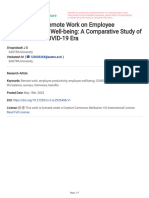Professional Documents
Culture Documents
1
1
Uploaded by
mundranehal3834Original Title
Copyright
Available Formats
Share this document
Did you find this document useful?
Is this content inappropriate?
Report this DocumentCopyright:
Available Formats
1
1
Uploaded by
mundranehal3834Copyright:
Available Formats
Impact of Remote Work on Employee Productivity
Overview
The rise of remote work, accelerated by the COVID-19 pandemic, has transformed traditional work
environments. This research delves into how remote work impacts employee productivity, examining
the benefits and challenges it presents. The analysis includes a review of productivity metrics before and
after the implementation of remote work policies, as well as the effects on work-life balance, employee
satisfaction, and engagement. It also considers the role of technological tools in facilitating remote work
and the challenges such as communication barriers and isolation.
Changes in Productivity Levels
Several studies indicate that remote work can lead to increased productivity. A 2020 study by Stanford
University found a 13% performance increase among remote workers due to fewer breaks, fewer sick
days, and a more comfortable working environment. However, this boost in productivity is not universal.
Other studies suggest that some employees experience a decline in productivity due to distractions at
home or inadequate workspaces. The variation in productivity levels can often be attributed to the
nature of the job, the individual's home environment, and personal work habits.
Impact on Work-Life Balance
Remote work significantly impacts employees' work-life balance. Many employees report a better
balance due to the elimination of commuting time and increased flexibility to manage personal and
professional responsibilities. A survey by Buffer in 2021 revealed that 98% of remote workers would like
to continue working remotely, at least part-time, due to improved work-life balance. However, the
blurring of boundaries between work and home life can also lead to overworking and burnout.
Employees may struggle to disconnect from work, leading to longer working hours and increased stress.
Technological Tools Facilitating Remote Work
The success of remote work heavily relies on technological tools that enable communication and
collaboration. Platforms like Zoom, Microsoft Teams, and Slack have become integral to maintaining
productivity and connectivity among remote teams. Project management tools such as Asana, Trello,
and Monday.com help track tasks and deadlines, ensuring that remote work remains organized and
efficient. These tools not only facilitate day-to-day operations but also support long-term project
planning and execution.
Employee Satisfaction and Engagement
Employee satisfaction and engagement can be positively influenced by remote work. Flexibility in work
hours and location allows employees to tailor their work environment to their preferences, often
leading to higher job satisfaction. Gallup's research shows that engaged employees are more productive,
less likely to leave their company, and better for business outcomes. Nevertheless, remote work can
also pose challenges to engagement, especially if employees feel disconnected from their team or the
company culture.
Challenges: Communication Barriers and Isolation
While remote work offers numerous benefits, it also introduces challenges such as communication
barriers and isolation. The lack of face-to-face interaction can hinder spontaneous communication and
idea sharing, potentially affecting team cohesion and innovation. Additionally, employees may
experience feelings of isolation and loneliness, which can negatively impact mental health and
productivity. Companies need to proactively address these issues by fostering a culture of open
communication and regular virtual social interactions.
Conclusion
The impact of remote work on employee productivity is multifaceted. While many employees
experience increased productivity and improved work-life balance, others may face challenges such as
distractions, overworking, and feelings of isolation. The effectiveness of remote work largely depends on
individual circumstances, the nature of the job, and the technological infrastructure in place. By
leveraging appropriate technological tools and fostering a supportive remote work culture, companies
can maximize the benefits of remote work while mitigating its challenges. Future research should
continue to explore the long-term effects of remote work on productivity and employee well-being,
particularly as hybrid work models become more prevalent.
You might also like
- CRI 211 Theories and Causes of Crimes - TancangcoDocument358 pagesCRI 211 Theories and Causes of Crimes - TancangcoJOHN PAUL AQUINO100% (4)
- Dysfunctional Attitude Scale DasDocument4 pagesDysfunctional Attitude Scale DasSuraj Shakya100% (3)
- Rdep Final Assign 1Document14 pagesRdep Final Assign 1api-527229141No ratings yet
- Nightingale Institute of Nursing, Noida: SeminarDocument10 pagesNightingale Institute of Nursing, Noida: SeminarDhAiRyA ArOrA100% (1)
- The Personality Parade - Training All Different Types of PeopleDocument28 pagesThe Personality Parade - Training All Different Types of PeopleWidya Mandala Language InstitueNo ratings yet
- Impact of Remote Work On Productivity and Work-Life BalanceDocument2 pagesImpact of Remote Work On Productivity and Work-Life Balance022MausamNo ratings yet
- The Impact of Remote Work On Productivity and WorkDocument3 pagesThe Impact of Remote Work On Productivity and WorkXaine PineraNo ratings yet
- Am Ethical Argument Essay Final DraftDocument9 pagesAm Ethical Argument Essay Final Draftapi-653628343100% (1)
- Blog 3Document2 pagesBlog 3Zaineb MatiullahNo ratings yet
- Investigating The Impact of Remote Work On Employee Well-Being and ProductivityDocument19 pagesInvestigating The Impact of Remote Work On Employee Well-Being and ProductivityGourav Rana100% (1)
- The Benefits and Challenges of Remote WorkDocument2 pagesThe Benefits and Challenges of Remote WorkJuan BrattiNo ratings yet
- 9Document2 pages9Irfan SadabNo ratings yet
- The Rise of Remote WorkDocument2 pagesThe Rise of Remote Worknoorjoni100No ratings yet
- 1Document1 page1workr285No ratings yet
- The Impact of Remote Work On ProductivityDocument2 pagesThe Impact of Remote Work On Productivitynajwalai98No ratings yet
- The Rise of Remote Work: Transforming The Modern WorkplaceDocument1 pageThe Rise of Remote Work: Transforming The Modern WorkplaceDiego VargasNo ratings yet
- TRS6 Test 2 WritingDocument3 pagesTRS6 Test 2 WritingQuốc AnhNo ratings yet
- Sample WorkDocument10 pagesSample WorkFajr MirNo ratings yet
- The Benefits and Challenges of Remote WorkDocument2 pagesThe Benefits and Challenges of Remote WorkerkanaptiNo ratings yet
- Trabalho de InglesDocument8 pagesTrabalho de InglesAdão Bila IdalécioNo ratings yet
- The Impact of Remote Work On Employee Productivity and Well-Being - A Comparative Study of Pre - and Post-COVID-19 EraDocument7 pagesThe Impact of Remote Work On Employee Productivity and Well-Being - A Comparative Study of Pre - and Post-COVID-19 Era23pba158ajiteshNo ratings yet
- 2 Advantage and DisadvantageDocument19 pages2 Advantage and DisadvantageMariam MiliNo ratings yet
- Navigating The Remote Work RevolutionDocument8 pagesNavigating The Remote Work Revolutionsarfrazahmed34357No ratings yet
- The Benefits and Challenges of Remote WorkDocument1 pageThe Benefits and Challenges of Remote WorkRicardo CukierNo ratings yet
- Impact of Remote Work Setup On Employee Work EfficiencyDocument15 pagesImpact of Remote Work Setup On Employee Work EfficiencyRajni KumariNo ratings yet
- Effect of Working From Home On Employees' Efficiency in The Public Sector Workplace in KentuckyDocument25 pagesEffect of Working From Home On Employees' Efficiency in The Public Sector Workplace in KentuckyjohnmorriscryptoNo ratings yet
- Ai 4Document1 pageAi 4mikeveb973No ratings yet
- Final ProjectDocument9 pagesFinal Projectvanldhe176194No ratings yet
- MSLD Sablock Charmane Capstone PaperDocument19 pagesMSLD Sablock Charmane Capstone PaperRezzaferNo ratings yet
- @annisuphere #Idea Sheet - Future of Remote WorkDocument12 pages@annisuphere #Idea Sheet - Future of Remote WorkninaNo ratings yet
- Measuring Performance of Employees Working RemotelyDocument4 pagesMeasuring Performance of Employees Working RemotelyTiera NicoleNo ratings yet
- The Benefits and Challenges of Remote WorkDocument1 pageThe Benefits and Challenges of Remote WorkAngBagong Barangay SanJuanNo ratings yet
- The Advantages and Disadvantages of TelecommutingDocument9 pagesThe Advantages and Disadvantages of Telecommuting王诗笛No ratings yet
- What Are The Long-Term Implications of Remote WorkDocument6 pagesWhat Are The Long-Term Implications of Remote WorkLexter GuranNo ratings yet
- Employee Engagement Strategy For Employees Working in Virtual Environment in The IT IndustryDocument11 pagesEmployee Engagement Strategy For Employees Working in Virtual Environment in The IT IndustryArpitaNo ratings yet
- The Influence of Teleworking On The Job Satisfaction, Employee Commitment and Productivity of The Employees During The COVID-19 PandemicDocument11 pagesThe Influence of Teleworking On The Job Satisfaction, Employee Commitment and Productivity of The Employees During The COVID-19 PandemicProme SahaNo ratings yet
- The Benefits and Challenges of Remote Wor1Document2 pagesThe Benefits and Challenges of Remote Wor1AngBagong Barangay SanJuanNo ratings yet
- Unit 11 Research Project BusinessDocument8 pagesUnit 11 Research Project BusinessAustin GomesNo ratings yet
- EJMCM - Volume 7 - Issue 3 - Pages 4621-4627Document7 pagesEJMCM - Volume 7 - Issue 3 - Pages 4621-4627Erin Jocas Umandap100% (1)
- Assignment 2 Chap 7 ProfDocument5 pagesAssignment 2 Chap 7 ProfMuhammad AliNo ratings yet
- Perceived Effects of Work From Office and Telecommuting On The Work Performance of AccountantsDocument16 pagesPerceived Effects of Work From Office and Telecommuting On The Work Performance of AccountantsMABALE Jeremy RancellNo ratings yet
- 2012 Executive DistributedWorkReportDocument13 pages2012 Executive DistributedWorkReportdesignedanddeliveredNo ratings yet
- Title 2Document2 pagesTitle 2pratheekshasnair002No ratings yet
- The Economic Perspective of Remote Working Places: July 2020Document13 pagesThe Economic Perspective of Remote Working Places: July 2020Emine MerterNo ratings yet
- The Evolution of Remote Work Navigating The Future of Flexible EmploymentDocument2 pagesThe Evolution of Remote Work Navigating The Future of Flexible EmploymentAntoine MNo ratings yet
- Digital Literacy Impact On Employees PerformanceDocument8 pagesDigital Literacy Impact On Employees Performance2022645954No ratings yet
- Remote Work and Work Life BalanceDocument35 pagesRemote Work and Work Life Balance23pba158ajiteshNo ratings yet
- Our Proposal 1Document7 pagesOur Proposal 1Greham NicoleNo ratings yet
- Emile Du Preez Week 8 Second Assessment PointDocument14 pagesEmile Du Preez Week 8 Second Assessment PointEmile Stephan Du PreezNo ratings yet
- The Impact of Remote Work On Productivity and Well-BeingDocument2 pagesThe Impact of Remote Work On Productivity and Well-BeinglalalaNo ratings yet
- Work From HomeDocument16 pagesWork From HomeKainath FarheenNo ratings yet
- Inter Organizational Relationship Post Covid:: A Blended Work EnvironmentDocument2 pagesInter Organizational Relationship Post Covid:: A Blended Work EnvironmentVivek BhartiNo ratings yet
- 15Document1 page15JhennNo ratings yet
- Working From Home in The United StatesDocument8 pagesWorking From Home in The United StatesPatricia AdierNo ratings yet
- Remote Work Pros and ConsDocument1 pageRemote Work Pros and ConssfgNo ratings yet
- Remote WorkDocument2 pagesRemote WorkEhab AlMukhaderNo ratings yet
- The Impact of Remote Work On Employee Performance and WellDocument2 pagesThe Impact of Remote Work On Employee Performance and WellDrazen JovicNo ratings yet
- Impact of Working Remotely On Productivity and ProfessionalismDocument3 pagesImpact of Working Remotely On Productivity and ProfessionalismAzrin ZulfakarNo ratings yet
- Entomo Shaping Employee Performance and Productivity in The Enterprises of TomorrowDocument12 pagesEntomo Shaping Employee Performance and Productivity in The Enterprises of TomorrowYoshi FlintNo ratings yet
- Impact of Remote and Hybrid WorkDocument7 pagesImpact of Remote and Hybrid Work23pba158ajiteshNo ratings yet
- Working From HomeDocument1 pageWorking From HomeVũNo ratings yet
- Telecommuting A Growing TrendDocument8 pagesTelecommuting A Growing TrendLTennNo ratings yet
- Speaking ComprehensiveDocument8 pagesSpeaking ComprehensivePhạm Thị Thùy TrangNo ratings yet
- Reflective-Essay 1.2Document3 pagesReflective-Essay 1.2Andrea MyrNo ratings yet
- Mastering Remote Work: This comprehensive guide empowers you to succeed in the world of remote work.From EverandMastering Remote Work: This comprehensive guide empowers you to succeed in the world of remote work.No ratings yet
- Article 2 - Exploring Compassionate Managerial Leadership Style in Reducing Employee Stress Level During COVID-19 Crisis The Case of NigeriaDocument3 pagesArticle 2 - Exploring Compassionate Managerial Leadership Style in Reducing Employee Stress Level During COVID-19 Crisis The Case of NigeriaAtif MemonNo ratings yet
- Learning Objectives: DR Karuna Sree P Member - MEUDocument39 pagesLearning Objectives: DR Karuna Sree P Member - MEUpodilashreeNo ratings yet
- Test Bank For Principles and Labs For Fitness and Wellness 13Th Edition Hoeger 1305251075 9781305251076 Full Chapter PDFDocument36 pagesTest Bank For Principles and Labs For Fitness and Wellness 13Th Edition Hoeger 1305251075 9781305251076 Full Chapter PDFsamuel.barnes374100% (11)
- Reflection Paper: Cavite State University Don Severino de Las Alas CampusDocument3 pagesReflection Paper: Cavite State University Don Severino de Las Alas CampusVincent PolicarNo ratings yet
- Packer Operator Performance R2Document13 pagesPacker Operator Performance R2Prakash SharmaNo ratings yet
- Stress ManagementDocument21 pagesStress ManagementToddy SamuelNo ratings yet
- 1.giáo Trình c1 Vstep - Student' S Book-Practice Test-1Document16 pages1.giáo Trình c1 Vstep - Student' S Book-Practice Test-1Hs TonyNo ratings yet
- STRATEGIES TO AVOID COMMUNICATION BREAKDOWN (Oral ComM3Q1)Document4 pagesSTRATEGIES TO AVOID COMMUNICATION BREAKDOWN (Oral ComM3Q1)Joshua Lander Soquita CadayonaNo ratings yet
- Theoretical Framework of Nola J. Pender 2Document4 pagesTheoretical Framework of Nola J. Pender 2almazan_jeizelNo ratings yet
- Reaction Paper Group 4 (SCHEDULING AND RISK ANALYSIS)Document2 pagesReaction Paper Group 4 (SCHEDULING AND RISK ANALYSIS)Jayson John CaroNo ratings yet
- (Small Books Big Ideas Population Health) Jaime Breilh - Critical Epidemiology and The People's Health-Oxford University Press (2021)Document277 pages(Small Books Big Ideas Population Health) Jaime Breilh - Critical Epidemiology and The People's Health-Oxford University Press (2021)Karolay SobalbarroNo ratings yet
- Daftar Peserta Ujian Tesis Profesi Ganjil 2021-Data Mba Nur Tanggal 23 Desember 2021Document179 pagesDaftar Peserta Ujian Tesis Profesi Ganjil 2021-Data Mba Nur Tanggal 23 Desember 2021Rachmad SantosoNo ratings yet
- Mental Health and Wellbeing Policy and ProcedureDocument3 pagesMental Health and Wellbeing Policy and ProcedurePrakash PandeyNo ratings yet
- Cockroach RepellentDocument6 pagesCockroach RepellentCharles Dave AvenidoNo ratings yet
- Unit GC1 Revision NotesDocument33 pagesUnit GC1 Revision NotesWafula Robert100% (1)
- Richardson 2009Document11 pagesRichardson 2009SalsaNo ratings yet
- Counseling Philosophy Advocacy PaperDocument1 pageCounseling Philosophy Advocacy Papertom goriNo ratings yet
- Teacher Burnout Literature ReviewDocument9 pagesTeacher Burnout Literature Reviewapi-528144614No ratings yet
- Personal Development Quarter 2 Week 6Document64 pagesPersonal Development Quarter 2 Week 6canasmaryruthNo ratings yet
- How To Let Go of Toxic RelationshipsDocument9 pagesHow To Let Go of Toxic RelationshipsMiri SimiNo ratings yet
- Personality Assessment Report NFFPS 30Document9 pagesPersonality Assessment Report NFFPS 30AdamBeyonceLoweNo ratings yet
- Final Reflective Practice WorksheetDocument6 pagesFinal Reflective Practice WorksheetJulie KiselevNo ratings yet
- GLASSElder Cohousing 3 Case Studies 2012Document19 pagesGLASSElder Cohousing 3 Case Studies 2012Bernice GonzalezNo ratings yet
- Breakthrough Coaching NLP Practitioner Training Module 8Document6 pagesBreakthrough Coaching NLP Practitioner Training Module 8Andrew MattNo ratings yet
- Basic Skills For Counselling Children: Facilitator's ManualDocument100 pagesBasic Skills For Counselling Children: Facilitator's ManualVijayalakshmi MaheshNo ratings yet

























































































